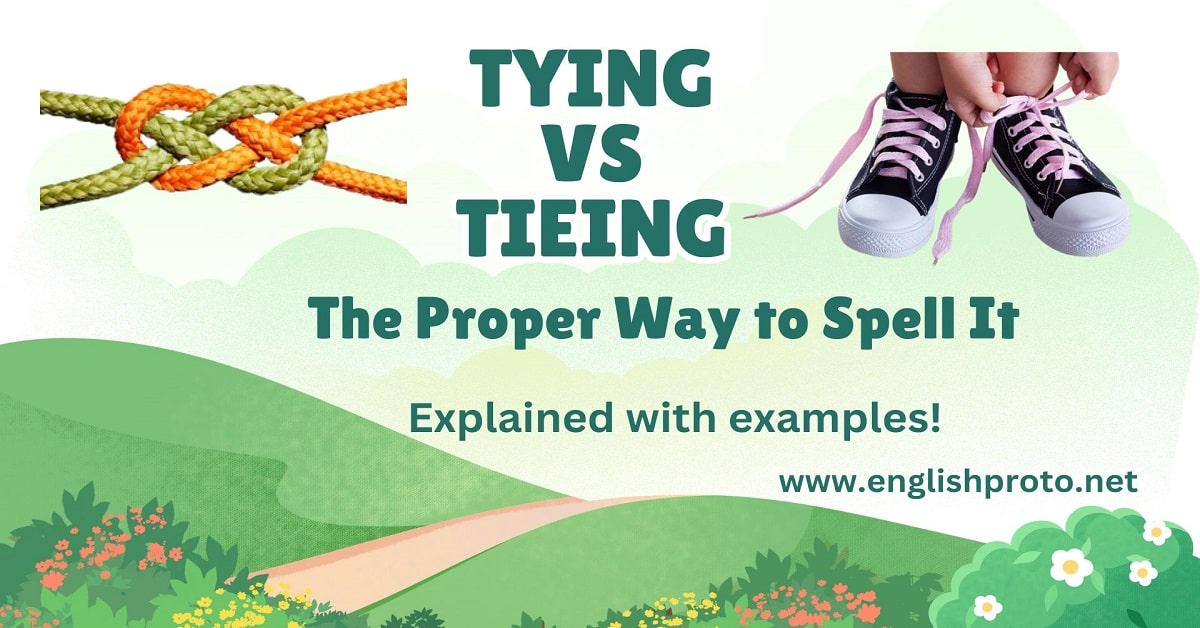Tying vs Tieing: Which Spelling Is Correct? It’s a question that might have crossed your mind more than once, especially when you’re unsure of which one to use in your writing.
Whether you’re crafting an email or writing an essay, getting these small details right can make all the difference. The truth is, many people mix up these two words, but don’t worry—you’re not alone!
In this article, we’ll clear up the confusion once and for all. By the end, you’ll know exactly when to use tying and why tieing is always a no-go. Let’s dive into the details and sharpen your writing skills!
Quick Summary: Tying vs Tieing
The correct spelling is tying. It is the present participle of the verb tie, which means to fasten, secure, or connect something. This form is used when describing the action of tying something in progress or as a continuous action.
The spelling tieing is incorrect. While it might seem logical to retain the “e” in tie when adding the -ing suffix, this construction doesn’t align with standard English grammar rules.
Key Takeaways:
- Tying is grammatically correct and widely accepted in English.
- It is formed by dropping the “-ie” in tie and replacing it with “-y” before adding -ing.
- Tieing is a common error caused by misunderstanding spelling conventions for verbs ending in “-ie.”
Reasons for Confusion: Tying vs Tieing
So, why does this simple word create so much uncertainty? There are a few main reasons:
1. English Spelling Patterns
English is notorious for its irregular spelling rules. Most verbs simply add -ing to form their present participles (e.g., running, swimming, eating). However, verbs ending in “-ie” follow a unique pattern where the “-ie” changes to -y before adding -ing.
This rule isn’t always intuitive, leading many to believe that tieing might be correct.
2. Pronunciation vs. Spelling
The word tie has a long vowel sound, and when spoken, the “e” is pronounced. This can mislead writers into thinking the “e” should remain in the present participle form.
For example:
- In tie, the “e” is pronounced.
- In tying, the “e” sound is implied but not written, which can seem counterintuitive.
3. Overgeneralization
Many English learners and native speakers overapply the standard rule of adding “-ing” to the base form of a verb. Since tie ends with a vowel-consonant combination, the mistake of writing tieing instead of tying becomes common.
4. Regional Influences
In some regions or informal contexts, the misspelling tieing is used colloquially, which further perpetuates the confusion. Exposure to such informal usage can make it difficult to determine the correct spelling.
Detailed Explanation: Why Tying is Correct
To form the present participle of verbs ending in “-ie,” the standard rule in English grammar is to replace -ie with -y and then add -ing. This transformation ensures the word is phonetically consistent and grammatically correct.
Examples of the Rule:
- Die → Dying
- Lie → Lying
- Tie → Tying
Why Does the “-ie” Change to “-y”?
The change occurs to avoid awkward or difficult-to-pronounce constructions. For instance:
- If tie became tieing, the result would look cumbersome and feel unnatural to read or say.
- Replacing -ie with -y simplifies the word’s flow, making it easier for readers and speakers to process.
What About Other Verbs Ending in “-ie”?
This rule applies universally to verbs ending in “-ie.” The adjustment ensures consistency across the language, maintaining simplicity and readability.
Common Errors and Why They Happen
Here are some common errors involving tying and their explanations:
| Incorrect Form | Why It’s Wrong |
|---|---|
| Tieing | Breaks the rule for verbs ending in “-ie,” creating an irregular and awkward form. |
| Tyeing | Misspells the root verb tie, leading to a non-existent word. |
| Ting | Drops the “e” entirely, forming an unrelated word with no connection to tie. |
⚡ Quick Tip: Always double-check verbs ending in “-ie” when adding -ing. If you’re unsure, consult a trusted grammar resource or dictionary.
Synonyms or Alternatives
Sometimes, you might want to avoid confusion altogether by using alternative words. Depending on the context, here are a few synonyms for tying:
- Fastening: “He was fastening the boat to the dock.”
- Securing: “The climber focused on securing her harness.”
- Binding: “The librarian was binding the old books.”
- Connecting: “She is connecting the two pieces of string.”
Using synonyms not only avoids overusing tying but also helps diversify your writing.
Examples in Sentences
Let’s reinforce the correct usage of tying with practical examples:
- “She was tying her shoelaces before the big race.”
- “The sailor spent hours tying intricate knots for the ship’s rigging.”
- “He’s known for tying the team together with his strong leadership skills.”
- “The kids were tying colorful ribbons to the balloons for the party.”
- “The gardener was tying the tomato plants to stakes for support.”
These examples highlight how tying seamlessly fits into various contexts, from casual activities to professional descriptions.
Origins and History of “Tying”
The word tie originates from Old English tīegan, meaning “to bind, fasten, or secure.” Its roots trace back to Proto-Germanic languages, where similar words were used to describe the act of connecting or securing objects.
As English evolved, so did its grammar rules. The transformation from tie to tying follows the linguistic trend of simplifying verb forms for ease of use and consistency.
Why Getting It Right Matters
Using the correct spelling of tying is about more than just grammar; it’s a reflection of your attention to detail. Whether you’re writing professionally or casually, proper spelling ensures clarity and avoids distracting readers with errors.
In professional settings, incorrect spelling can undermine credibility. For example:
- A resume with “tieing” instead of “tying” might suggest carelessness.
- A marketing email with spelling errors could make a brand appear unprofessional.
Common Misconceptions Debunked
1. Isn’t “Tieing” a Variant Spelling?
No. Unlike some words that have alternate spellings (e.g., color/colour), tieing is not recognized as a valid form in any variant of English. Tying is the universally accepted spelling.
2. But It’s Used Informally. Isn’t That Okay?
While informal usage might be common, it doesn’t make the word correct. In formal writing or communication, always use tying.
Conclusion: Tying vs Tieing
The debate between tying and tieing may seem like a small detail, but it highlights the importance of understanding English grammar and spelling rules. By using tying, you align with established conventions, ensuring your writing is clear, professional, and error-free.
Next time you’re describing the act of fastening, connecting, or securing something, remember: tying is the correct form. Mastering small nuances like this can make a big difference in how polished and credible your writing appears.
So, keep this rule in mind and tie your thoughts together with confidence!



